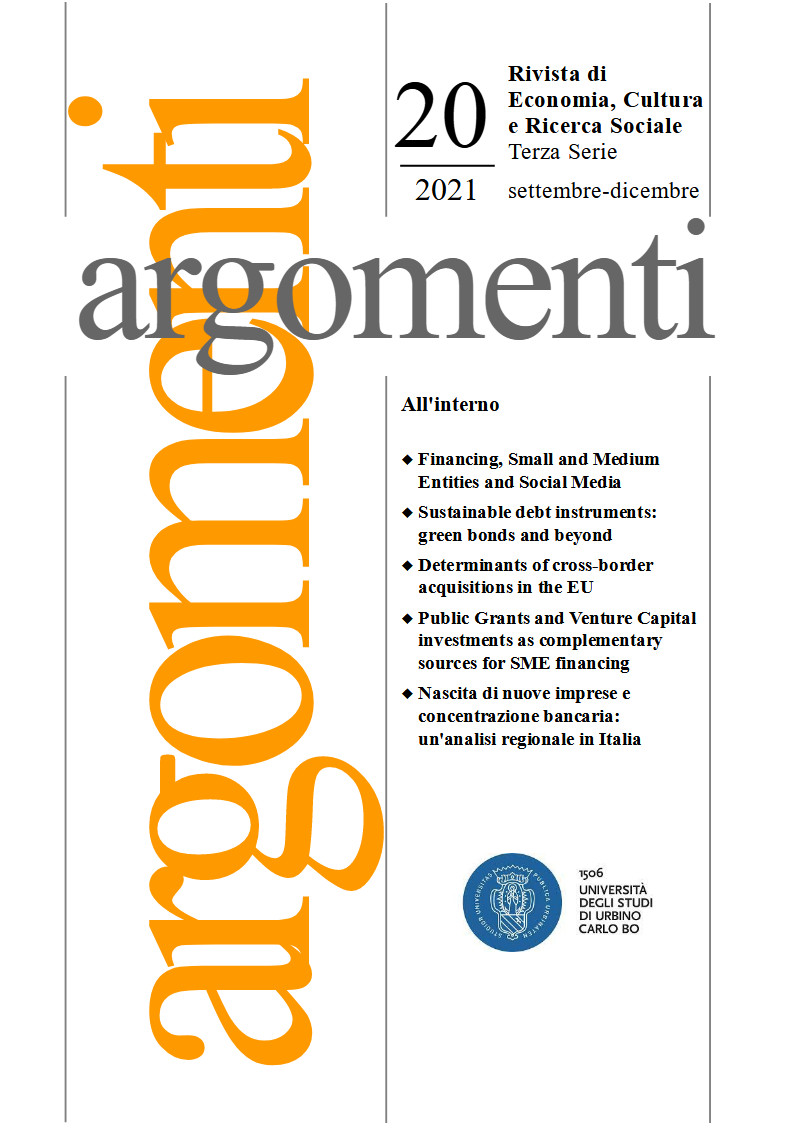Abstract
This paper analyzes whether the regional distribution of new firms is shaped by market concentration of the local banking industry. The case of Italy is considered, where important mergers and acquisitions between banks have been carried out recently. The empirical analysis is based on provincial data (NUTS-3 level) in the period 2011-2019. The results indicate that bank concentration and firm creation have an inverted U-shaped relationship: bank concentration fosters firm creation in those provinces characterized by low levels of concentration, while it reduces new firm creation in the provinces with high concentration. Overall, these findings suggest that concentration of the local banking industry affects the regional distribution of new firms and can increase regional economic disparities.
References
Acs Z. J., Storey D. J. (2004) Introduction: entrepreneurship and economic development. Regional Studies, 38, 871–877.
Alessandrini, P., Presbitero, A. F., & Zazzaro, A. (2009). Banks, distances and firms' financing constraints. Review of Finance, 13(2), 261-307.
Alessandrini, P., Presbitero, A. F., & Zazzaro, A. (2009b). Global banking and local markets: a national perspective. Cambridge Journal of Regions, Economy and Society, 2(2), 173-192.
Alessandrini, P. Fratianni, M., Papi, L., & Zazzaro, A. (2016). Banks, Re-gions and Development After the Crisis and Under the New Regulatory Sys-tem. Credit and Capital Markets, 5, 536-560.
Alessandrini, P., Croci, M., & Zazzaro, A. (2009). The Geography of Bank-ing Power: The Role of Functional Distance, 99-123, in B. Damiano Silipo ed. The Banks and the Italian Economy. Springer, 2009.
Backman, M. (2015). Banks and new firm formation. Journal of Small Busi-ness and Enterprise Development, 22(4), 734–761.
Bergantino, A.S., & Capozza, C. (2012). The effect of bank concentration on entrepreneurship in central and Eastern European transition countries. Work-ing Paper Series 0043, Università di Bari
Berger, A., Miller, N. H., Petersen M. A. (2005). Does function follow or-ganizational form? Evidence from the lending practices of large and small banks. Journal of Financial Economics, 76(2), 237-269.
Besanko, D., & Thakor, A.V. (1992). Banking deregulation: allocational consequences of relaxing entry barriers. Journal of Banking and Finance, 16(5), 909–932.
Black, S.E., & Strahan, P.E. (2004). Business formation and the deregulation of the banking industry. In Holtz-Eakin, D., & Rosen, H.D. (Eds.) Public policy and the economics of entrepreneurship (pp. 59–82). Cambridge: MIT Press
Bonaccorsi di Patti, E., & Dell’Ariccia, G. (2004). Banking competition and firm creation. Journal of Money, Credit and Banking, 36(2), 225–251.
Carillo, M. R., Pennacchio, L., & Rossano, D. (2018). Gli effetti della ri-forma del credito cooperativo sulle disparità economiche regionali. Rivista Trimestrale di Diritto dell’Economia, 3, 122-147.
Cetorelli, N., & Strahan, P.E. (2006). Finance as a barrier to entry: bank com-petition and industry structure in local US markets. The Journal of Finance, 61(1), 437–461.
Chiappori, P., Perez-Castrillo, D., Verdier, T. (1995). Spatial competition in the banking system: localization, cross subsidies and the regulation of de-posit rates. European Economic Review, 39, 889–918.
Del Monte, A., Moccia, S., Pennacchio, L. (2021). Cultural environment, entrepreneurship and innovation in Europe. The importance of history. Il capitale culturale, Studies on the Value of Cultural Heritage, 23, 111-139.
Del Monte, A., Pennacchio, L. (2020). Historical roots of regional entrepre-neurship: the role of knowledge and creativity. Small Business Economics, 55, 1-22.
Del Monte, A., Moccia, S., Pennacchio, L. (2020). Regional entrepreneur-ship and innovation: historical roots and the impact on the growth of regions. Small Business Economics.
Dell’Aricca, G. & Marquez, R. (2006). Lending Booms and Lending Stand-ards. The Journal of Finance, 61(5), 2511-2546.
Elitcha, K. (2021). The moderating role of stock markets in the bank compe-tition-entrepreneurship relationship. Small Business Economics, 56(4), 1333-1360
Feldman, M. P. (2001). The Entrepreneurial Event Revisited: Firm For-mation in a Regional Context Maryann. Industrial and Corporate Change, 10 (4), 861–891.
Fritsch, M., & Storey, D. J. (2014). Entrepreneurship in a regional context: historical roots, recent developments and future challenges. Regional Stud-ies, 48(6), 939–954.
Gagliardi, F. (2009). Banking market structure, creation and activity of firms: early evidence for cooperatives in the Italian case. Annals of Public and Cooperative Economics, 80(4), 605–640.
Guzman, M. (2000). Bank structure, capital accumulation and growth: a sim-ple macroeconomic model. Economic Theory, 16(2), 421–455.
Hasan, I., Jackowicz, K., Kowalewski, O., & Kozłowski, Ł. (2019). The eco-nomic impact of changes in local bank presence. Regional Studies, 53(5), 644-656.
Jackson, J. E., & Thomas, A. R. (1995). Bank structure and new business creation lessons from an earlier time. Regional Science and Urban Econom-ics, 25(3), 323-353.
Petersen, M., & Rajan, R. (1995). The effect of credit marketcompetition on lending relationships. Quarterly Journal of Economics, 110, 407–443.
Rogers, T.M. (2012). Bank market structure and entrepreneurship. Small Business Economics, 39(4), 909–920.
Sapienza, P. (2002). The effects of banking mergers on loan contracts. The Journal of Finance, 57(1), 329-67.
Stam, E. (2007) Why butterflies don’t leave: locational behaviour of entre-preneurial firms. Economic Geography, 83, 27–50.
Wall, H.J. (2004). Entrepreneurship and the deregulation of banking. Eco-nomic Letters, 82(3), 333–339.

This work is licensed under a Creative Commons Attribution 4.0 International License.
Copyright (c) 2022 Luca Pennacchio, Sara Moccia

